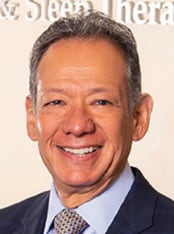Dr. Steven Olmos notes that flexibility in treatment options is imperative to the dental sleep practice, and the Diamond Digital Sleep Orthotic and Shirazi Hybrid are just two devices that continue to improve treatment options and versatility.
 by Steven Olmos, DDS, DABCP, DABCDSM, D.ABDSM, DAIPM, FAAOP, FAACP, FICCMO, FADI, FIAO
by Steven Olmos, DDS, DABCP, DABCDSM, D.ABDSM, DAIPM, FAAOP, FAACP, FICCMO, FADI, FIAO
Sleep disordered breathing (SDB) is comprised of various structural and neural pathologies of the upper airway. Obstructive sleep apnea (OSA) is among the most prevalent forms of SDB. Regardless of disease severity, OSA has a host of metabolic and cardiovascular comorbid conditions. Mild and moderate apnea is often treated with positive pressure devices including APAP, BiPAP, and CPAP. However, 46% to 83% of patients are nonadherent if compliance is defined as usage for 4 or more hours per night.1
The critical pressure needed to collapse the pharyngeal airway is known as P-Crit. This can be altered by nasal valve compromise or other nasal obstruction. Oral appliances are recognized by the American Academy of Sleep Medicine and as an effective treatment option for OSA. P-Crit can also be affected by the use of oral appliances that give tonus to the muscular airway, essentially stretching the muscle to improve its responsiveness which reduces collapse. This is the basis of how oral appliances function to treat OSA.
There are two commonly used techniques for taking a bite relation for the production of oral appliances. The George Gauge Registration (GGR) usually starts from 60% protrusion and then the mandible is titrated for efficacy. This technique can result in temporomandibular dysfunction. The second commonly employed technique, the Sibilant Phoneme Registration (SPR), uses a physiologic three-dimensional mandibular orientation without significant protrusion to give tonus to the airway. A retrospective analysis comparing the results of each technique showed no difference in outcome. The SPR method required fewer calibrations and less jaw movement though.2 The SPR technique was quantified using the pharyngometer which is instrumentation utilizing acoustic reflection to quantify changes in airway from baseline to collapse.3 Using a pharyngometer to measure the volume of the pharyngeal airway and how much it collapses can be a valuable tool to triage whether a patient will have a successful outcome with oral appliance therapy.
As with PAP treatments, there are multiple types of oral appliances. Devices that can titrate protrusively, vertically, and lift the tongue are optimal for management of this condition. As of this writing there is only one oral device that allows for these changes, and that is the Diamond Digital Sleep Orthotic (DDSO-Diamond Orthotic Laboratory). It is a printed type 12 nylon that is biocompatible and fully adjustable (figure 1). This device is FDA-cleared for the treatment of sleep breathing disorders including OSA. Improved nasal patency utilizing nasal sprays and nasal dilators can increase the efficacy of oral appliance therapy for OSA according to the Starling Resistor model.
Chronic facial pain and primary headaches (migraine, tension type, cluster) are comorbid with OSA.4 In severe cases of OSA or in situations where there is facial pain and osteoarthritis of the temporo-mandibular joints in combination with OSA, a hybrid or combined therapy option may be the solution. In severe OSA cases when the patient cannot tolerate exceedingly high PAP pressures, a combination of oral appliance and PAP can be used to reduce PAP pressures to tolerable and comfortable levels.5 Patient complaints about head straps can be resolved via a printed oral appliance that holds a nasal pillow delivery of positive pressure. This appliance is called the Shirazi Hybrid (Diamond Orthotic Laboratory) and can be titrated protrusively and vertically (figure 1). This appliance will decompress the TMJ and limit parafunctional movement so it can be used in patients with TMD and OSA. Innovation and technological developments continue to improve treatment options and versatility.
Flexibility in treatment options allows Dr. Olmos to offer treatments related to TMJ function as well as OSA. Read about rhinomanometry measurements and airflow-related treatment for improved TMJ function here:
https://dentalsleeppractice.com/case-report/rhinomanometry-measuring-nasal-flowrate-to-improve-tmj-function/
- PC Neuzeret, L Morin. Impact of different nasal masks on CPAP therapy for obstructive sleep apnea: a randomized comparative trial. Clin Respir J 2016. [Epub ahead of print].
- Viviano J, Klauer D, Olmos S, Viviano D. Retrospective comparison of the George Gauge registration and the sibilant phoneme registration for constructing OSA oral appliances. Jour Craniomand & Sleep Practice. 2019 Nov 26;1-9.
- Singh GD, Olmos SR. Use of a sibilant phoneme registration protocol to prevent upper airway collapse in patients with TMD. Sleep Breath. 2007 Dec;11(4):209-16.
- Olmos SR. Comorbidities of chronic facial pain and obstructive sleep apnea. Curr Opin Pulm Med. 2016 Nov;22(6):570-5.
- El-Solh AA, Moitheennazima B, Akinnusi ME, Churder PM, Lafornara AM. Combined oral appliance and positive airway pressure therapy for obstructive sleep apnea: a pilot study. Sleep and Breathing 15, 203-208 (2011).
 Steven Olmos, DDS, is an international educator and founder of TMJ & Sleep Therapy Centres International. He is a diplomate of the American Board of Crainofacial Dental Sleep Medicine, the American Board of Dental Sleep Medicine, the American Board of Craniofacial Pain, and the Academy of Integrative Pain Management.
Steven Olmos, DDS, is an international educator and founder of TMJ & Sleep Therapy Centres International. He is a diplomate of the American Board of Crainofacial Dental Sleep Medicine, the American Board of Dental Sleep Medicine, the American Board of Craniofacial Pain, and the Academy of Integrative Pain Management.